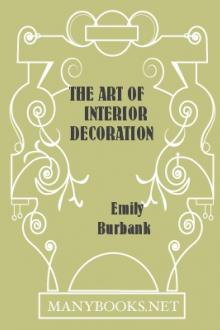The Art of Interior Decoration by Emily Burbank (good summer reads TXT) 📕

- Author: Emily Burbank
- Performer: -
Book online «The Art of Interior Decoration by Emily Burbank (good summer reads TXT) 📕». Author Emily Burbank
In furniture, the epoch-making styles have been those showing line, and if decorated, then only with such decorations as were subservient to line; pure Greek and purest Roman, Gothic and early Renaissance, the best of the Louis, Directoire and First Empire, Chippendale, Adam, Sheraton and Heppelwhite.
The bad styles are those where ornamentations envelop and conceal line as in late Renaissance, the Italian Rococo, the Portuguese Barrocco (baroque), the curving and contorted degenerate forms of Louis XIV and XV and the Victorian—all examples of the same thing, i.e.: perfect line achieved, acclaimed, flattered, losing its head and going to the bad in extravagant exuberance of over-ornamentation.
There is a psychic connection between the outline of furniture and the inline of man.
Perfect line, chaste ornamentation, the elimination of the superfluous was the result of the Greek idea of restraint—self-control in all things and in all expression. The immense authority of the law-makers enforced simple austerity as the right and only setting for the daily life of an Athenian, worthy of the name. There were exceptions, but as a rule all citizens, regardless of their wealth and station, had impressed upon them the civic obligation to express their taste for the beautiful, in the erecting of public buildings in their city of Athens, monuments of perfect art, by God-like artists, Phidias, Apelles, and Praxiteles.
CHAPTER XV CONTINUATION OF PERIODS IN FURNITUREFrom Greece, culture, borne on the wings of the arts, moved on to Rome, and at first, Roman architecture and decoration reproduced only the classic Greek types; but, as Rome grew, her arts took on another and very different outline, showing how the history of decorative art is to a fascinating degree the history of customs and manners.
Rome became prosperous, greedy, powerful and imperious, enslaving the civilised world, and, not having the restraining laws of Greece, waxed luxurious and licentious, and chafed, in consequence, at the austere rigidity of the Greek style of furnishing.
We know that in the time of Augustus Cæsar the Romans had wonderful furniture of the most costly kind, made from cedar, pine, elm, olive, ash, ilex, beach and maple, carved to represent the legs, feet, hoofs and heads of animals, as in earlier days was the fashion in Assyria, Egypt and Greece, while intricate carvings in relief, showed Greek subjects taken from mythology and legend. Cæsar, it is related, owned a table costing a million sesterces ($40,000).
But gradually the pure line swerved, ever more and more influenced by the Orient, for Rome, always successful in war, had established colonies in the East. Soon Byzantine art reached Rome, bringing its arabesques and geometrical designs, its warm, glowing colours, soft cushions, gorgeous hangings, embroideries, and rich carpets. In fact all the glowing luxury that the new Roman craved.
The effect of this mésalliance upon all Art, including interior decoration, was to cause its immediate decline. Elaboration and banal designs, too much splendour of gold and silver and ivory inlaid with gold, resulted in a decadent art which reflected a decadent race and Rome fell! Not all at once; it took five hundred years for the neighbouring races to crush her power, but continuous hectoring did it, in 476 A.D. Then began the Dark Ages merging into the Middle Ages (fifth to fifteenth centuries).
Dark they were, but what picturesque and productive darkness! Rome fell, but the Carlovingian family arose, and with it the great nations of Western Europe, to give us, especially in France, another supreme flowering of interior decoration. Britain was torn from the grasp of Rome by the Saxons, Danes and Normans, and as a result the great Anglo-Saxon race was born to create art periods. Mahomet appeared and scored as an epoch-maker, recording a remarkable life and a spiritual cycle. The Moors conquered Spain, but in so doing enriched her arts a thousandfold, leaving the Alhambra as a beacon-light through the ages. Finally the crusades united all warring races against the infidels. Blood was shed, but at the same time routes were opened up, by which the arts, as well as the commerce, of the Orient, reached Europe. And so the Byzantine continued to contend with Gothic art—that art which preceded from the Christian Church and stretched like a canopy over Western Europe, all through the Middle Ages. It was in the churches and monasteries that Christian art, driven from pillar to post by wars, was obliged to take refuge, and there produced that marvellous development known as the Gothic style,—of the Church, for the Church, by the Church, perfected in countless Gothic cathedrals,—crystallised glorias lifting their manifold spires to heaven,—ethereal monuments of an intrepid Faith which gave material form to its adoration, its fasting and prayer, in an unrivalled art.
There is one early Gothic chair which has come down to us, Charlemagne's, made of gilt-bronze and preserved in the Louvre, at Paris. Any knowledge beyond this one piece, as to what Carlovingian furniture was like (the eighth century) we get only from old manuscripts which show it to have been the pseudo-classic, that is, the classic modified by Byzantine influence, and very like the Empire style of Napoleon I. Here is the reason for the type. Constantinople was the capital of the Eastern Empire, when in 726 A.D., Emperor Leo III prohibited image worship, and the artists and artisans of his part of the world, in order to earn a livelihood, scattered over Europe, settling in the various capitals, where they were eagerly welcomed and employed.
Even so late as the tenth to fourteenth centuries the knowledge we have of Gothic furniture still comes from illustrated manuscripts and missals preserved in museums or in the national libraries.
Rome fell as an empire in the fifth century. In the eighth century, Venice asserted herself, later becoming the great, wealthy, Merchant City of Eastern Europe, the golden gate between Byzantium and the West (eleventh to fifteenth centuries). Her merchants visiting every country naturally carried home all art expressions, but, so far as we know, her own chief artistic output in very early days, was in the nature of richly carved wooden furniture, no specimens of which remain.
CHAPTER XVI THE GOTHIC PERIODThe Gothic Period is the pointed period, and dominated the art of Europe from about the tenth to the fifteenth century. Its origin was Teutonic, its development and perfection French.
At first, the house of a feudal lord meant one large hall with a raised dais, curtained off for him and his immediate family, and subdivided into sleeping apartments for the women. On this dais a table ran crossways, at which the lord and his family with their guests, ate, while a few steps lower, at a long table running lengthwise of the hall, sat the retainers. The hall was, also, the living-room for all within the walls of the castle. Sand was strewn on the stone floor and the dogs of the knights ate what was thrown to them, gnawing the bones at their leisure. This rude scene was surrounded by wonderful tapestries hung from the walls:—woman's record of man's deeds.
Later, we read of stairs and of another room known as the Parloir or talking-room, and here begins the sub-division of homes, which in democratic America has arrived at a point where more than 200 rooms are often sheltered under one private roof!
Oak chests figured prominently among the furnishings of a Gothic home, because the possessions of those feudal lords, who were constantly at war with one another, often had to be moved in haste. As men's lives became more settled, their possessions gradually multiplied; but even at the end of the eleventh century bedsteads were provided only for the nobility, probably on account of expense, as they were very grand affairs, carved and draped. To that time and later belong the wonderfully carved presses or wardrobes.
Carved wood panelling was an important addition to interior decoration during the reign of Henry III (1216-72).
In the thirteenth and fourteenth centuries England with Flanders led in the production of mediæval art.
Hallmarks of the Gothic period are animals and reptiles carved to ornament the structural parts of furniture and to ornament panels. Favourite subjects with the wood carvers of that time were scenes from the lives of the saints (the Church dominated the State) and from the romances, chanted by the minstrels.
CHAPTER XVII THE RENAISSANCEFollowing the Gothic Period came the Renaissance of Greek art which began in Italy under the leadership of Leonardo Da Vinci and Raphael, who, rejecting the existing types of degraded decorative art, in Italy a combination of the Byzantine and Gothic—turned to the antique, the purest Greek styles of Pericles' time. The result was another period of perfect line and proportion, called the Italian Renaissance, a great wave of art which swept over all Europe, gaining impetus from the wise patronage of the ruling Medicis. One of them (Pope Leo X with the co-operation of Italy's reigning dukes and princes) employed and so developed the extraordinary powers of Michael Angelo, Titian, Raphael, Andrea del Sarto and Correggio.
By the end of the fifteenth century, Classic Greek art was engrossing the mind of Western Europe, classical literature was becoming the fashion and there was even an attempt to make Latin the popular language.
It was during the Renaissance that Palladio rebuilt the palaces of Italy,—beautiful beyond words, and that Benvenuto Cellini designed in gold, silver and bronze in a manner never since equalled. From that same period dates the world-famous Majolica of Urbino, Pesaro and Gubbio, shown in our museums. So far as house-furnishing went, aside from palaces, there was but little that was appropriate for intimate domestic life. The early Renaissance furniture was palatial, architectural in outline and, one might almost say, in proportions. The tables were impossibly high, the chairs were stiff, and the cabinets immense and formal in outline. It had, however, much stately beauty, and very lovely are certain old pieces of carved and gilded wood where the gilt, put on over a red preparation and highly burnished, has rubbed off with time, and shows a soft glow of colour through the gold.
But as always, the curse of over-elaboration to please perverted minds, was resorted to by cabinet-makers who copied mosaics with their inlaying, and invented that form known as pietra-dura—polished bits of marble, agates, pebbles and lapis lazuli. Ivory was carved and used as bas-reliefs and ivory and tortoise shell, brass and mother-of-pearl used as inlay. Elaborate Arabesque designs inlaid were souvenirs of the Orient, and where the cabinetmaker's saw left a line, the cuts were filled in with black wood or stained glue, which brought out the design and so gave an added decorative effect. Skilled artisans had other designs bitten into wood by acids, and shading was managed by pouring hot sand on the surface of the wood. Hallmarks of the Renaissance are designs which were taken from Greek and Roman mythology, and allegories representing the elements, seasons, months and virtues. Also, battle scenes and triumphal marches.
The insatiable love for decoration found still another expression in silver and gold plaques of the highest artistic quality, embossed and engraved for those princes of Florence, Urbino, Ferrara, Rome, Venice and Naples, who vied with one another in extravagance until the inevitable reaction came.
An example of good mantel decoration. The vases and clock are Empire, the chairs Directoire, and footstools Louis XV.
A low bowl of modern green Venetian glass holds flowers.
Edmund Bonneffé says that in the latter part of the Renaissance, while the effort of the Italians seems to have been to disguise





Comments (0)